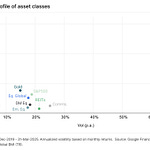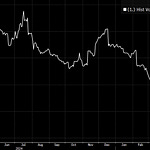If you are not a subscriber of The Pomp Letter, join 215,000 other investors who read my personal opinion on finance, technology, and bitcoin each morning.
To investors,
There has been significant scrutiny of the US monetary and fiscal policy decisions over the last decade. The proponents believe that the various activities have helped mitigate severe short-term pain during the Global Financial Crisis and COVID-19 pandemic. The critics believe that market intervention has continued to kick the can down the road and created a larger problem that will only lead to more pain in the future.
Maybe one side of the debate is right, but more likely, each argument has an element of truth to them. It is possible for people in positions of leadership to mitigate short-term pain at the expense of long-term crisis. In fact, I would argue this is the most accurate analysis of the past decade or so.
A key driver of these monetary and fiscal policy drivers is inflation targeting. Sarwat Jahan writes for the IMF:
“In recent years, many central banks, the makers of monetary policy, have adopted a technique called inflation targeting to control the general rise in the price level. In this framework, a central bank estimates and makes public a projected, or “target,” inflation rate and then attempts to steer actual inflation toward that target, using such tools as interest rate changes. Because interest rates and inflation rates tend to move in opposite directions, the likely actions a central bank will take to raise or lower interest rates become more transparent under an inflation targeting policy. Advocates of inflation targeting think this leads to increased economic stability.”
When describing why inflation targeting is so effective, Jahan writes:
“In general, a monetary policy framework provides a nominal anchor to the economy. A nominal anchor is a variable policymakers can use to tie down the price level.”
To better understand how inflation targeting works, Sarwat Jahan highlighted:
“Inflation targeting is straightforward, at least in theory. The central bank forecasts the future path of inflation and compares it with the target inflation rate (the rate the government believes is appropriate for the economy). The difference between the forecast and the target determines how much monetary policy has to be adjusted. Some countries have chosen inflation targets with symmetrical ranges around a midpoint, while others have identified only a target rate or an upper limit to inflation. Most countries have set their inflation targets in the low single digits. A major advantage of inflation targeting is that it combines elements of both “rules” and “discretion” in monetary policy. This “constrained discretion” framework combines two distinct elements: a precise numerical target for inflation in the medium term and a response to economic shocks in the short term.”
Lastly, Jahan explains what is required for inflation targeting to be effective:
“Inflation targeting requires two things. The first is a central bank able to conduct monetary policy with some degree of independence. No central bank can be entirely independent of government influence, but it must be free in choosing the instruments to achieve the rate of inflation that the government deems appropriate. Fiscal policy considerations cannot dictate monetary policy. The second requirement is the willingness and ability of the monetary authorities not to target other indicators, such as wages, the level of employment, or the exchange rate.”
Alright, so now that we understand how inflation targeting works, why it is important, and what is required, you are probably wondering why I am spending so much time on a nuanced aspect of the financial market.
The answer is that I have an intuition that the Federal Reserve is preparing to significantly increase the target inflation rate.
This decision will not be taken lightly by the central bank and their leadership, but it ultimately signals that inflation has escaped their control and rather than pull it back in with aggressive monetary policy decisions, the next best option is to simply manipulate the benchmark to make the situation appear less bad.
This isn’t a random conspiracy theory, nor is it an uniquely original idea. Yesterday CNBC had a conversation with Mohamed El-Erian, the Chief Economic Adviser of Allianz and former CEO of PIMCO, where they discussed this very topic of inflation target increases.

The idea of increasing the inflation target by 50% is fairly extreme, but humans like round numbers and this would be a full-on capitulation by the Federal Reserve. They may not have many other options. Before the inflation target is increased though, it will be important to pay attention to the mainstream media conversation.
My expectation is that there will be a flurry of expert guests who start to float this idea, which will then normalize it in the eyes of the market. Once the market has begun to digest the change and potential impact, the Federal Reserve will have the ability to make the change without as much pushback or negative impact.
There is no guarantee that the inflation target is going to be increased. This is just a hunch at the moment. After I watched El-Erian discuss the prospects of a change so openly though, it became more obvious to me that this is a very real option on the table now. I’ll do my best to unpack the ramifications of a decision like this in a future letter. For now, it is important to keep your eyes open and your head on a swivel.
50% increases in the inflation target by the world’s most established economy, and most trusted central bank, don’t exactly happen all the time. The impact will be interesting to watch. Hope you all have a great day. I’ll talk to everyone tomorrow.
-Pomp
If you are not a subscriber of The Pomp Letter, join 215,000 other investors who read my personal opinion on finance, technology, and bitcoin each morning.
SPONSORED: Brave Wallet is the first secure wallet built natively in a web3 crypto browser. No extension required.
With Brave Wallet, you can buy, store, send, and swap assets. Manage your portfolio & NFTs. View real-time market data with an integrated CoinGecko dashboard. Even connect other wallets and DApps. All from the security of the best privacy browser on the market.
Protect your crypto. Whether you’re new to crypto, or a seasoned pro, it’s time to ditch those risky extensions. It’s time to switch to Brave Wallet.
Download Brave at brave.com/Pomp, and click the wallet icon to get started.
Codie Sanchez is an entrepreneur, investor and the founder of the "Contrarian Thinking" Newsletter. She focuses on acquiring small businesses with hopes of turning them into immediate cashflow.
In this conversation, we talk about all the "boring" businesses that will give you cashflow and help build an incredible portfolio. We cover everything from ice machines, ATMS, and renting out your pool and car. Codie and I also talk about new sectors in tech that she's excited about and how you can make $1000 a week if you're just starting out.
Listen on iTunes: Click here
Listen on Spotify: Click here
Americans Will Not Be Able To Live With These Food Prices — Darius Dale:
Podcast Sponsors
These companies make the podcast possible, so go check them out and thank them for their support!
Fundrise is largest direct-to-investor real estate investment platform. Go to Fundrise.com/Pomp today and get $10 when you place your first investment.
Unstoppable Domains’ 10 NFT domain endings are now fully integrated with Trust Wallet. Claim your Unstoppable Domain here today.
Brave Wallet is the first secure crypto wallet built natively in a web3 crypto browser. Download the Brave privacy browser at brave.com/Pomp today.
BetOnline allows you to use Bitcoin and other altcoins to bet on sports, casino games, horse racing, poker and more. Click here and use PROMO CODE: POMP100 to receive a 100% matching bonus on your first crypto deposit.
Abra lets you trade, borrow, and earn interest on crypto. Earn up to 13% interest on USD stablecoins or crypto, borrow USD stablecoins, and trade in 110+ cryptocurrencies in a simple, secure app. Download Abra and get $15 in free crypto when you fund your account.
FTX US is the safe, regulated way to buy digital assets. Trade crypto with up to 85% lower fees than top competitors by signing up at FTX.US today.
Compass Mining is the world's first online marketplace for bitcoin mining hardware and hosting. Visit compassmining.io to start mining bitcoin today!
Choice is rebuilding the way bitcoiners approach retirement by making it possible to invest in digital assets inside your IRA. Visit choiceapp.io/pomp
BlockFi provides financial products for crypto investors. Those products include BlockFi Wallet, no fee Trading, crypto collateralized Loans and the World's First Crypto Rewards Credit Card. To get $75 back on the first swipe of your BlockFi Rewards Credit Card, sign up today at http://www.blockfi.com/Pompcc
LMAX Digital is the market-leading solution for institutional crypto trading & custodial services. Learn more at LMAXdigital.com/pomp
Okcoin is the first licensed exchange to bring new cryptos to market. To get started, and go to okcoin.com/pomp
Exodus is the world’s leading desktop, mobile, and hardware crypto wallets, with over 150 assets. Founded in 2015 to empower people to control their wealth. Visithttp://exodus.com/pomp today.
You are receiving The Pomp Letter because you either signed up or you attended one of the events that I spoke at. Feel free to unsubscribe if you aren’t finding this valuable. Nothing in this email is intended to serve as financial advice. Do your own research.














Share this post